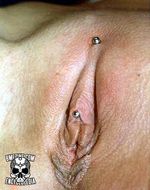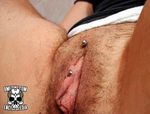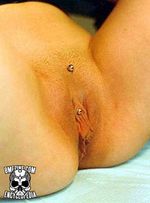Nefertiti piercing
The Nefertiti piercing combines the benefits of a hood piercing with the visual appeal of a Christina piercing. This piercing is believed to have been first popularized by Shane Munce. The piercing is, of course, named after the Egyptian Queen Nefertiti, renowned for her beauty. Although she was not actually of royal blood, she captured the imagination of artists of the time and is one of the most-recorded Egyptian figures.
The lower half of this piercing should be treated as a vertical hood piercing would, while the top should be treated as a surface piercing. Jewelry is usually a flexible bar such as tygon or nylon jewelry, although metal could be used. This piercing is generally considered much safer than the similarly placed — but deeper — Isabella piercing.


